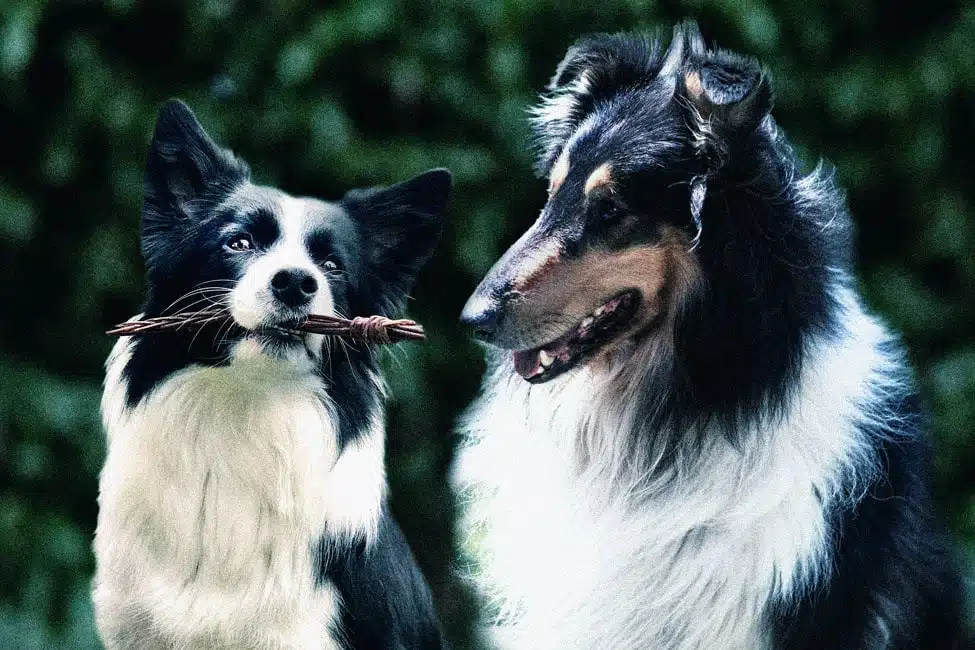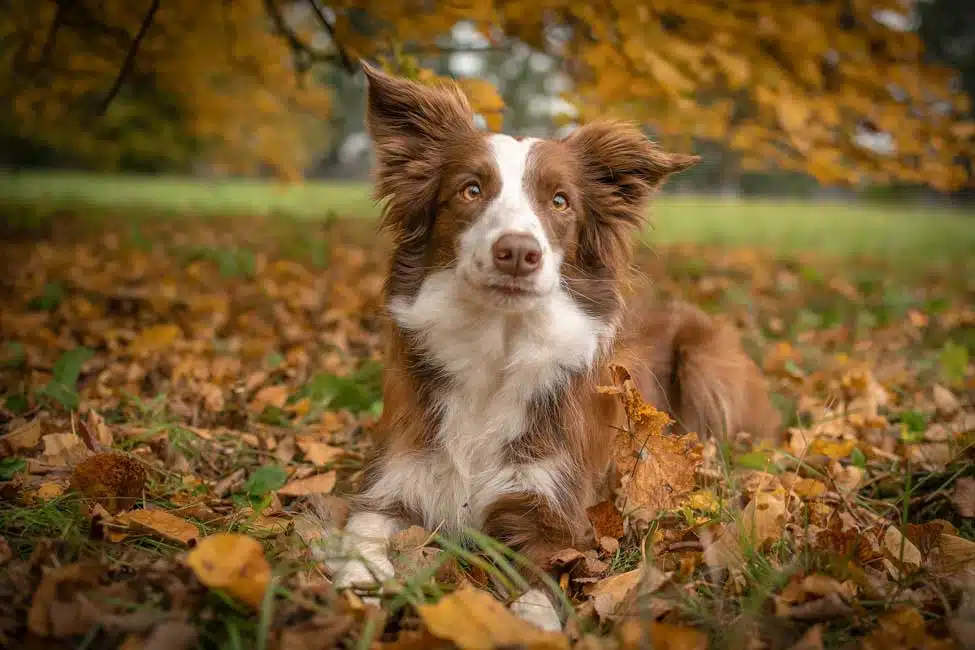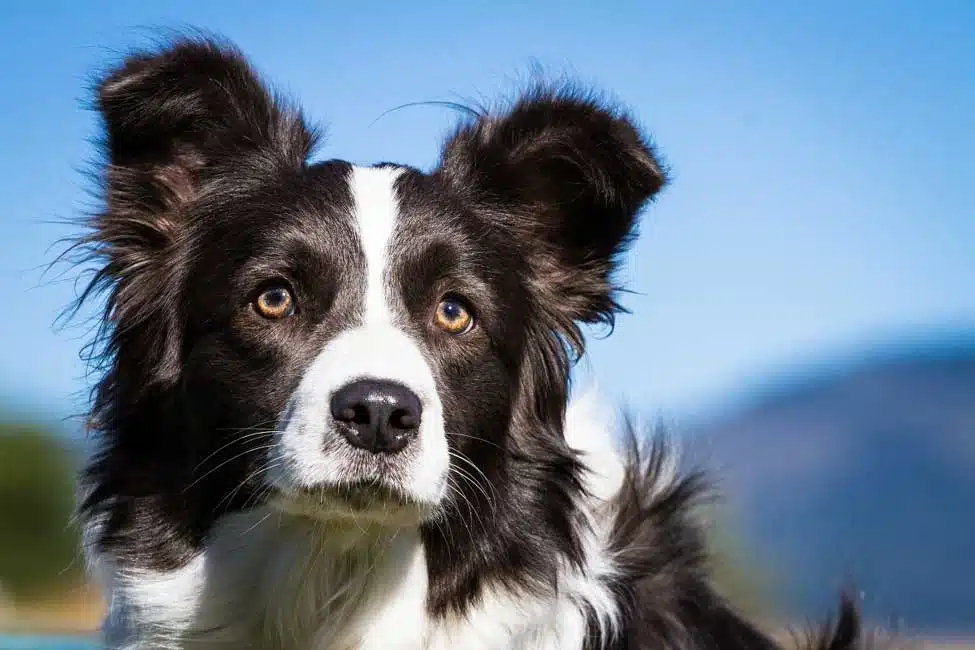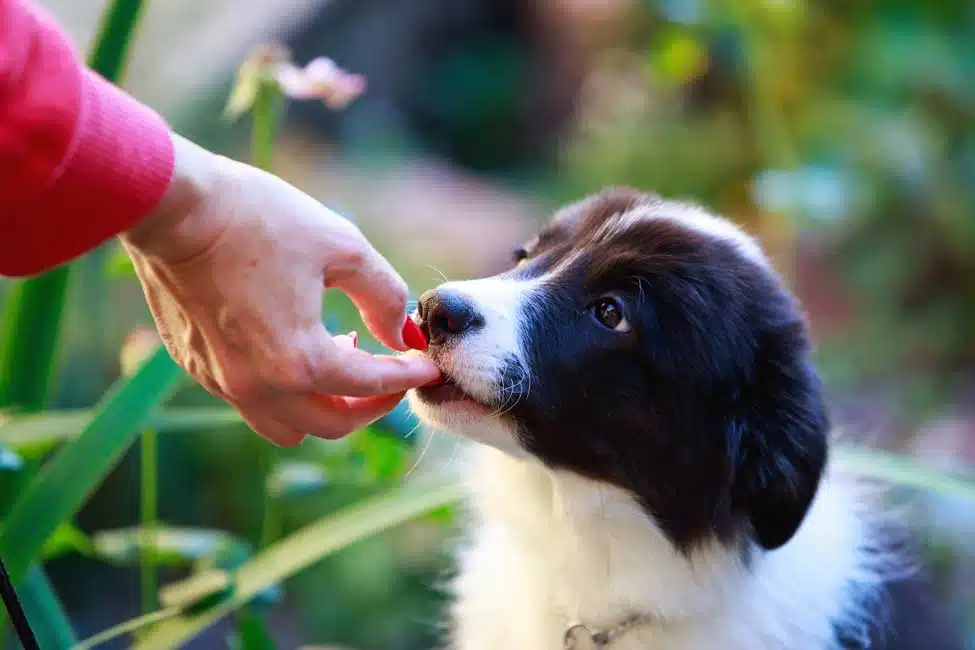
If you’re searching for a dog breed that brings together compelling beauty, a fantastic work ethic, and innate intelligence that shines from bright eyes, the Collie is a superior choice. From their long, elegant muzzles to their surprisingly light and nimble step, these herding dogs are a wonderful family pet for all types of households. Their mild nature makes them suitable for nearly any environment, and their patient, trainable behavior makes them adept at everything from canine companionship to acting as a loyal guard dog. There’s a lot to explore with this beloved breed, however – and there’s no better way to start learning than with these 10 fun facts about Collie dogs:
1) Collies and Border Collies are different breeds: While they both have “Collie” in their name and share some characteristics, Collies and Border Collies are visually distinct. A Border Collie looks similar to a smooth-coated Standard Collie but is more streamlined and generally smaller. The breed name comes from their location of origin – the border between Scotland and England. The name “Collie” itself is thought by some to be a nod to the dogs’ original coal-black coat, filtered through the brogue of a Gaelic accent: coaly.
2) Their tail position has a distinct purpose: When in “working mode,” the Collie’s tail hangs down between their back legs, although untucked. This keeps it out of the way of wayward hooves, should their livestock charges get a little feisty. Once the herd has been gathered and it’s time to head in, however, the tail will go up as the dog guides both human master and animal flock back home safe. One of the more interesting Collie fun facts has to do with the tip of their tail. The flare of white found at the end of both Standard and Border Collies’ tails has a special nickname: the Shepherd’s Lantern, as the bright white hue makes it easy to spot in low-light conditions.
3) Border Collies excel at agility: All the instinctual moves required by these high-energy herding dogs translate very well to competition and stage alike. The American Kennel Club (AKC) notes that Border Collies frequently make it to the top of the leaderboards in formal agility competitions. The same breed has a loyal fan following as well, thanks to crowd-pleasing performances on major entertainment shows like America’s Got Talent. Able to “dance” on their hind paws by jumping with proper training, these pups can also weave in and out of their handler’s feet with amazing dexterity, both forwards and backward. Just like other herding breeds, you can train a Collie quite easily, as long as their humans are diligent with practices.
4) The Standard Collie has two coat variations: The most well-known coat variant of the Standard Collie is the “rough” coat, which isn’t rough so much as it is voluminous. This puffy double-coat needs diligent grooming to stay looking healthy and beautiful, and is also the source of substantial shedding during the dog’s annual or twice-yearly “coat blow.” Keep in mind that Collies are not hypogenic dogs. Their shedding may pose an issue to individuals who are sensitive to pet dander. A Standard Collie with a smooth coat is short-haired by contrast, with slightly less shedding to contend with. The smooth coat’s lack of volume gives the dog a very different silhouette compared to that of the rough coat: when seeing one for the first time, it’s easy to understand how they’re mistaken for Border Collies.
5) There are 4 recognized coat colors in the Standard Collie: The AKC lists the accepted and recognized colors like white, tri-color (white, brown, and black), sable and white (brown and white), and blue merle (mottled blue-grey, black, and white). The latter is the coloring gene trait that gives some Standard and Border Collies their bright blue or unusual (e.g. differently-colored) eyes, as well as beautiful multi-color coats. The mottled merle pattern isn’t judged any differently from a professional perspective, but it is prized as an aesthetic by Collie owners with pups that share the characteristic coat. While it might seem like a good idea to breed merled coat dogs together, this has a chance of introducing eye and ear abnormalities in Border Collie puppies: the merle gene is closely linked to the development genes of the eyes and ears. This is why most breeders will only breed a merle with a non-merle coated Collie out of caution and concern for the health of the offspring.
6) While generally well-mannered, Collies aren’t silent: Because many, even most, Collie owners take the time to train and work with their dogs, an out-of-control Collie isn’t a familiar sight. In fact, the Standard Collie’s mild nature and personality traits have led some prospective owners to wonder if, like the Basenji breed, Collies don’t bark. They do in fact bark and are prone to doing so if they are bored, crated for an excessive period of time, or left to their own devices while pet parents are off to work. Potential Collie owners should not mistake a calm momentary demeanor for a trait that will last a lifetime. Providing these dogs with plenty of toys and engagement is the key to saving your furniture, giving your family peace and quiet, and establishing a bond with your Collie.
7) Border Collies are physiologically shaped for herding: Beyond a general affinity to rounding up animals, Border Collies actually have a skeletal structure that supports their signature move: the crouch. A space between their shoulder blades allows these dogs to comfortably lower their torso to the ground while keeping their hindquarters at a standing position, moving all the while. This move gets them closer to the heels and hooves of the animals they’re trained to herd, allowing them to nip and guide the pack with precision and a clear view. Combined with their dynamic tail positions and expressive ears, watching the body movements of a Collie at work is truly a sight to behold. Whether these dogs are herd sheep or not, they should constantly receive physical and mental stimulation to stay happy and healthy.
8) Intense staring is part of the package: Anyone who has owned a dog knows that chowing down on a particularly delicious snack is bound to get you a lot of canine attention. Border Collies, however, take this move to the next level. An intense, eye-locking gaze from your beloved pet can feel a little unnerving – particularly when you recall that domestic dogs descended from wolves. Not to worry, however, if your Border Collie is giving you “the eye”, they’re just demonstrating one of their most skillful herding tricks. Livestock is, by and large, prey animals. This intense stare mimics predatory behavior, triggering the pack to go in the direction the dog wants them to.
9) They aren’t exactly contenders for the most independent dog: Because the breed was created to be a working dog, everything in their genetics is keyed to stick close to their human companion. An energetic working dog like a Collie needs physical and mental stimulation for their own well-being, not to mention access to frequent exercise. Remember, this breed is built to run across wide fields and plains, staying out all day to manage and watch after the herd – lazy napping in front of the TV isn’t likely to appeal, particularly to younger Border Collie puppies. Be prepared for loud barking and potentially destructive boredom-based behaviors if you routinely leave a Collie alone all day.
10) The Border Collie family tree starts with a substantial trunk: Some dog breeds are a bit of a mystery, with only oral history and genetic research to guide investigative dives. Today’s Border Collies all – or, at least, mostly all – share a common ancestor: Old Hemp. Born in 1893, he fathered a staggering 200 documented pups over the course of his studying lifetime, all of which carried an enviable genetic predisposition. Old Hemp was known for his quiet and relatively non-aggressive herding technique, a benefit that owners looking for an excellent herding dog clamored for. A later 1901 addition to the breed’s genetics, Old Kemp, was thought to have added a pleasant human-friendly disposition and the breed’s notorious intense gaze-as-herding-technique.
The Keys to Happy Collie Ownership: What Every Pet Parent Should Know
The Collie breed’s gentle disposition, combined with a ready-when-needed work ethic, has made them a mainstay dog for suburban homes and working livestock farms alike. Their highly intelligent nature may take a little patience to unlock, but grateful Collie owners agree that the time it takes is well worth it. The single most-repeated training tip for Collies is to use positive reinforcement, rather than negative punishment: these breeds are sensitive, willful, and capable of holding a grudge over bad handling.
A Collie’s need for energy should be addressed by their pet parent in two distinct ways: with healthy input (such a natural, premium grain-free kibble dog food like Lucy Pet) and frequent exercise in the form of walks, indoor play, and potentially – provided the dog is both interested and socialized – trips to the dog park. When it comes to a dog’s diet, make sure you are feeding them the best food for a Collie. And don’t forget to keep your Collie’s gorgeous coat clean and knot-free – Lucy Pet carries a full line of awesome-scented dog shampoo and leave-in conditioning spray, perfect for detangling and grooming.
Remember, as a breed created to serve and pay close attention to their human handlers, a Collie needs a steady hand and a commitment to training routines in order to thrive. As with any new dog, there may be a few bumps in the road, but remain by their side and you’ll find an incredibly talented, loyal, and loving Collie as your faithful companion.
Sources Cited:
- “Collie.” American Kennel Club (AKC.org), no publish date, https://www.akc.org/dog-breeds/collie/. Accessed December 12, 2019.
- Upmalis, Jordan. “Which Breeds Excel in Agility?” American Kennel Club (AKC.org), December 17, 2016, https://www.akc.org/expert-advice/news/which-breeds-excel-in-agility/. Accessed December 12, 2019.
- OConnell, Rebecca. “11 Bright Facts About Border Collies.” Mental Floss.com, August 15, 2015, https://www.mentalfloss.com/article/67113/11-bright-facts-about-border-collies. Accessed December 12, 2019.
- Moll, Kathy V. “Collie Kaleidoscope.” CollieHealth.org, (no publish date),
- https://www.colliehealth.org/variations-collie-color/. Accessed December 12, 2019.
- Collie vs Border Collie: What’s the Difference: https://www.lucypetproducts.com/blog/collie-vs-border-collie
- A Helpful Guide to the Best Food for Border Collies: https://www.lucypetproducts.com/blog/helpful-guide-to-the-best-food-for-collie-dogs





Leave A Comment
You must be logged in to post a comment.